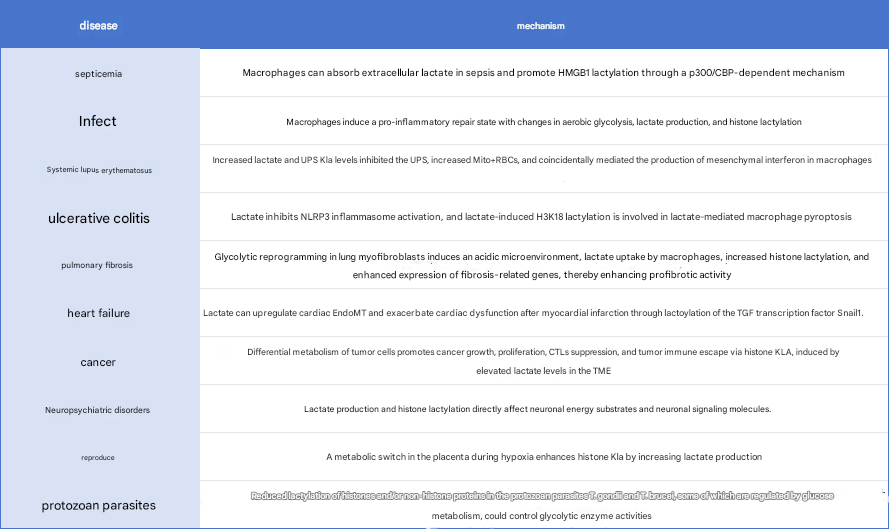Pan-Modification Shines Bright: L-Lactylation

Recent Advances
Lactylation is a novel post-translational modification that primarily occurs on lysine residues of histones in response to the accumulation of lactate during cellular metabolism. This modification is also referred to as lysine lactylation (Kla). Lactylation alters the spatial conformation of histones, thereby influencing gene transcription and regulating the expression of related genes. Lactylation not only plays a significant role in tumorigenesis, sepsis, and immune-related diseases but is also closely associated with metabolic reprogramming in cells.
Lactylation Isomers
Metabolites produced during glycolysis may induce different isomers, and the distribution of these isomers in cells, as well as their association with the Warburg effect, is a current area of intense research. The three main isomers include:
L-Lactyllysine (KL-la): This is a post-translational modification (PTM) driven by L-lactate and is considered a primary responder to glycolysis and the Warburg effect. L-lactylation is widely present in various tissues and organs and plays a crucial role in numerous physiological and pathological processes.
D-Lactyllysine (KD-la): This is the stereoisomer of L-lactylation, formed through a non-enzymatic reaction between S-D-lactylglutathione (LGSH), produced via the glyoxalase pathway, and proteins. The glyoxalase pathway is an efficient cellular detoxification system composed of two enzymes, glyoxalase 1 (GLO1) and glyoxalase 2 (GLO2). GLO1 combines the glycolysis byproduct methylglyoxal (MGO) with glutathione to form LGSH, while GLO2 hydrolyzes it to produce D-lactate and regenerate glutathione.
Carboxyethyllysine (Kce): This modification is generated by the direct reaction of methylglyoxal (MGO) with lysine residues. MGO is a highly reactive glycolysis byproduct that can react with various protein residues, including cysteine, arginine, and lysine. The formation of N-ε-(carboxyethyl)lysine (Kce) from lysine has been observed in cells, although its levels are lower than those of MGO-derived arginine modifications.
Biological Functions of L-Lactylation
L-lactylation is the most extensively studied type of lactylation modification and is closely associated with L-lactate produced during glycolysis. L-lactate is the primary form of lactate in humans and eukaryotes, generated by the reduction of pyruvate to L-lactate via lactate dehydrogenase (LDH-A). L-lactylation plays a central role in glycolysis and the Warburg effect in eukaryotes, widely present in various tissues and organs, and is significant in cancer, cardiovascular diseases, brain disorders, and digestive system diseases. This modification alters the spatial conformation and function of proteins, influencing gene expression and playing a key role in cellular metabolism, signal transduction, and epigenetic regulation.
Diseases Associated with Lactylation
Lactylation is a multifunctional biochemical process involved in various physiological and pathological processes during development and disease, with these processes involving different mechanisms.
Cancer
Lactate metabolism differs between tumor cells and normal cells. Normal cells primarily generate energy through mitochondrial oxidative phosphorylation under oxygen-rich conditions, while lactate is produced via glycolysis under hypoxic conditions. In contrast, tumor cells produce large amounts of lactate through glycolysis even under aerobic conditions, a phenomenon known as the Warburg effect. This metabolic adaptation not only provides rapid energy supply but also creates a metabolic environment that supports rapid biosynthesis for tumor cell growth and proliferation. Additionally, lactate produced by tumor cells can be transported to the tumor microenvironment via monocarboxylate transporters, affecting the pH balance and potentially serving as an energy source for other cells. This metabolic difference underscores the critical role of lactate in tumor development.
Infection and Inflammation
Lactate accumulation may regulate macrophage polarization, leading to distinct immune cell-specific effects. Lactylation regulates gene expression during the differentiation of inflammatory macrophages. Circulating lactate levels are recognized as biomarkers for the severity and mortality of sepsis. During sepsis, macrophages can uptake extracellular lactate, and the increase in intracellular lactate promotes chromatin-bound HMGB1 lactylation through a p300/CBP-dependent mechanism, facilitating HMGB1 release in exosomes. Lactylated HMGB1 in exosomes leads to endothelial barrier dysfunction and increased vascular permeability, explaining its pro-inflammatory properties.
Autoimmune Diseases
Increased lactate uptake in macrophages inhibits excessive NLRP3 inflammasome activation and subsequent macrophage apoptosis by reducing caspase-1, the inflammasome sensor NLRP3, and the adaptor protein ASC in both human and mouse models of ulcerative colitis. Additionally, lactate-induced lactylation of H3K18 is involved in lactate-mediated macrophage apoptosis and the amelioration of ulcerative colitis in humans and mice.
Lactylation-Related Diseases
As an emerging epigenetic regulatory mechanism, lactylation has demonstrated broad influence in disease models and pathological studies by modulating protein function and stability, participating in key cellular processes. Research on L-lactylation helps deepen our understanding of protein function and regulatory mechanisms, particularly in pathological states such as cancer, sepsis, and autoimmune diseases, where L-lactate levels are significantly elevated and play a critical role.
S-RMab® Antibodies
Starter introduces new lactylation pan-modification antibodies, histone H3 lactylation modification antibodies, and antibody kits! High-specificity, high-dilution rabbit antibodies are available for your selection.
Product Information
| Gatalog Num | Product Name | Product Parameters | Price |
| S0M1014 | Lactyl Histone H3 Antibody MiniAb Set | $210 | |
| S0B0756 | Histone H3 (Lactyl K9) Recombinant Rabbit mAb (S-R397) | Host : Rabbit | Inquiry |
| Conjugation : Unconjugated | |||
| S0B0719 | L-Lactyl Lysine Rabbit Polyclonal Antibody | Host : Rabbit | Inquiry |
| Conjugation : Unconjugated |





